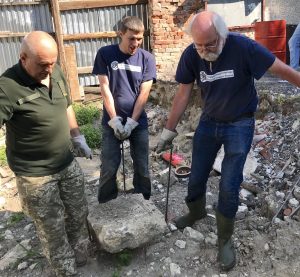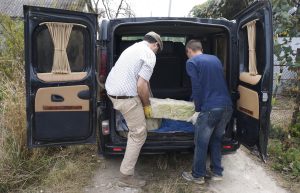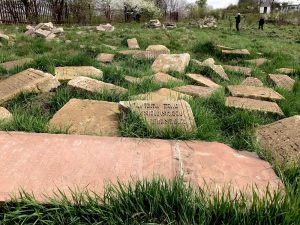![]() Ця сторінка також доступна українською.
Ця сторінка також доступна українською.
Introduction
This page summarizes and analyzes an ongoing project which collects displaced Jewish headstone fragments in the city of Rohatyn in the Rohatyn raion of the Ivano-Frankivsk oblast in western Ukraine, and transports them for safekeeping to the old Jewish cemetery in the city. The project has been conducted informally and formally by different activists over the past decades. Although there are concepts and plans to conserve and document the stone fragments and incorporate them into a memorial at the old cemetery site, this project summary focuses primarily on their recovery and return.
This page is intended as a reference for similar projects now in the planning stages in western Ukraine or beyond. Following a brief summary of the site, the material below describes the project and reviews its effectiveness together with a listing of issues encountered, approximate project costs, and ongoing risks. Related projects both in western Ukraine and elsewhere in Europe are also briefly mentioned, for comparison. At the bottom of this page are links to project documentation and to additional reference information about the burial site and related projects.
Read the overview to case studies of selected projects at Jewish burial sites in western Ukraine.
Project Summary
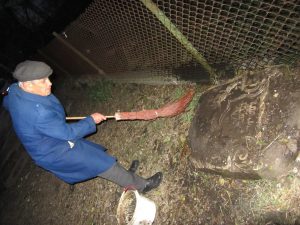
Retired teacher Mykhailo Vorobets cleaning a Jewish headstone newly recovered from a street in Rohatyn. Photo © RJH.
Project type: Identification, recovery, and return of Jewish headstone fragments which were taken from Jewish cemeteries during WWII and misused as building materials during and after the war.
Location and site type: The headstone fragments were and are scattered around the city of Rohatyn, Rohatyn raion, Ivano-Frankivsk oblast, Ukraine. The fragments are currently being returned to and preserved at the old Jewish cemetery in Rohatyn. GPS: 49.40769 24.61589.
Description of the site: Rohatyn is a small city of 8 to 10 thousand people in the Hnyla Lypa River valley, covering a roughly triangular area about 4 km² (1.5 mi²). To date, headstone fragments have been found at locations all over the city, except in the north. The city retains some of its multicultural heritage, including two Jewish cemeteries, four Christian cemeteries, plus Austro-Hungarian and Turkish WWI soldiers’ cemeteries; five historic churches and a ruined beit midrash, and numerous Ukrainian, Soviet, and Jewish memorials.
Ownership and stakeholders: The old cemetery site is owned by the municipality of Rohatyn, and the municipality also has a management responsibility for the city’s streets and roads, and its utility services. Some headstone recovery locations have been on private property. Stakeholders include the local civil community, foreign descendants of Rohatyn pre-war Jewish and other families, historians, and students of Jewish culture.
Official heritage status: The Jewish cemeteries of Rohatyn have no current national or regional registration, but are indicated on the Rohatyn city administration general development plan and map, and are subject to permission agreements for care of the sites assigned by the Rohatyn raion administration to the Rohatyn city administration and by the city administration to the NGO Rohatyn Jewish Heritage.
Activists working on/at the site: Rohatyn Jewish Heritage (RJH), a registered Ukrainian non-profit organization based in Lviv, Ukraine. Contact info. Rohatyn city staff, residents, and local leaders including retired teacher Mykhailo Vorobets.
Other projects active at the site: The Jewish cemeteries of Rohatyn are the subjects of several heritage preservation projects in progress or in planning. See the RJH project overview web page for a complete list with links. See also case study 05 (cemetery vegetation clearing), case study 10 (mass grave landscaping and memorial plan), case study 16 (digital communication for heritage), and case study 17 (multi-facet cemetery rehabilitation) on this website for other Jewish heritage projects in Rohatyn.
Project Analysis
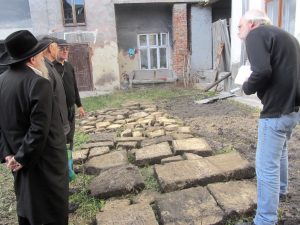
Dozens of large and small Jewish headstone fragments excavated from a courtyard behind a former Gestapo office in Rohatyn. Photo © RJH.
History of the site: Rohatyn’s first or “old” Jewish cemetery dates from the 17th century, and served the community on a one-hectare site not far from the city center until it was closed due to overcrowding in the early 20th century; the second or “new” cemetery then opened and served until the Jewish community was destroyed in 1943. Sometime during the German occupation of WWII, thousands of headstones were broken and “harvested” from the old cemetery for use as construction material in Rohatyn, primarily under road and parking surfaces at locations important to the occupying authorities. After the war, other Jewish headstone fragments were also used in official and private building projects in the city. Following Ukraine’s independence, as headstone fragments surfaced from time to time, Jewish survivors of the Holocaust in Rohatyn and their families arranged with residents of Rohatyn to move the stones to the Jewish cemeteries; by the first decade of the new millennium, when most of those survivors had passed, about 30 fragments and a few intact headstones had been collected and secured.
The recovery project began again in 2011 through an informal partnership between local retired teacher Mykhailo Vorobets in Rohatyn and the next generation of Rohatyn Jewish descendants working in what would later be formalized as the Ukrainian non-profit NGO Rohatyn Jewish Heritage (RJH). With small-donation funding from other Rohatyn Jewish descendants and cooperation from the city administration of Rohatyn, RJH and Vorobets recovered and returned more than 500 headstone fragments in the next eight years, and the work continues.
Current features of/at the site: An interactive map of Jewish headstone fragment recovery sites in Rohatyn illustrates the broad reuse of the stones during and after the war all over the city. Reports of headstone discoveries by Rohatyn residents and the city administration are passed to RJH through Vorobets and through social media every year. The stones are found under streets and roads when resurfacing or utility works are done; at the edges of roads in walkways, driveways, and creek culverts; in the foundations, walls, and cellars of disused buildings; in residential and commercial courtyards and parking areas; under private gardens; at the riverside; and in any place where stone blocks could have been useful in the past.
Details of the project: The project is documented and funded as part of the overall Jewish heritage management work of RJH. Small donations are collected by hand or through a cooperative agreement with Gesher Galicia, a registered US 501(c)(3) educational non-profit organization, which then transfers working funds to RJH in Ukraine. As reports of new headstone discoveries are reported and verified, arrangements are made with regional volunteers or local labor to recover the stones and transport them to the old Jewish cemetery in Rohatyn; typically the work, like the report which initiates it, is arranged impromptu, but at times the Rohatyn city administration participates. Currently the stones are simply laid or piled on the grass in one corner of the cemetery, to be used in a memorial project which highlights their cultural significance both for the Jewish community of Rohatyn and as part of the city’s diverse history.
As the ongoing Jewish cemetery rehabilitation work in Rohatyn becomes better known among local residents, more frequently now individual headstone fragments are returned to the old cemetery anonymously, presumably as they are discovered in small construction works by cemetery neighbors and others. Local church leaders have spoken about the issue to their parishioners and encouraged this benevolent action.
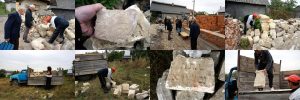
Jewish headstones extracted from an old building and returned to the cemetery by a Rohatyn resident. Photos © RJH.
Issues encountered in the project: The number of newly-discovered Jewish headstone fragments reported each year is unpredictable and highly variable, from a handful some years to nearly 200 in one year; this makes planning and resourcing for labor and transportation difficult. In past years, through the resident coordination of Mykhailo Vorobets, spontaneous transport arrangements could be made informally and with little cost, as workers had time and vehicles available. Currently RJH can recover and transport small numbers of stones with its own volunteers when in Rohatyn for other heritage work, the number of stones limited by the carrying capacity of a rented van. When another large batch of stones becomes available for recovery as has occurred a few times in past years, different arrangements will need to be organized through regional professionals.
Project costs, one-time and sustaining: There is no typical cost of recovery and transport for an individual fragment; the circumstances and available resources for each recovery is different. In addition, some past recoveries also incur costs for back-filling and repair of soil disturbed by the extraction of stones, particularly in gardens; these additional costs are likely to continue in the future. RJH reports on their project page that the total recovery cost for the first eight years of work was US$535, averaging around one dollar per stone – but that average combines frequent no-cost local volunteer work (a resource which may not be available for future efforts) with hired labor and vehicles for other recoveries.
At present RJH is not considering proactive recovery efforts, e.g. to contract for the excavation of streets, parking areas, or other land filled with headstones, or for the demolition of buildings. Accelerating the recovery work this way would entail much higher expense, require careful coordination with the Rohatyn city administration, and disrupt the lives of Rohatyn residents.
Current risks to preservation: Estimates of the number of Jewish headstones and fragments still hidden under roads, buildings, and gardens in Rohatyn vary, but RJH believes only a small fraction of the original count of matzevot in the cemeteries have been recovered to date; a few prewar photographs and one very brief film show the old Jewish cemetery as a thick forest of stones, probably in the thousands, and most headstones were probably broken into 3 to 5 fragments. It is unlikely that anything close to all of the lost stones will ever be recovered, but even a large fraction of the original count would overwhelm the cemetery memorial as currently proposed.
There is no impediment to ongoing recovery work from the Rohatyn city administration or its citizens. On the contrary, the residents encourage the work and support it in small ways as they can.
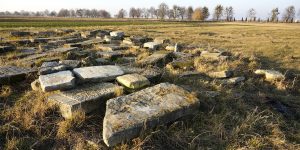
Recovered headstones returned by local neighbors and ESJF to the Jewish cemetery in Sokolivka. Photo © RJH.
Related projects in western Ukraine: Wartime and postwar misuse of Jewish headstones in construction work was extensive in western Ukraine; under Ukraine’s independence, citizens and NGOs are motivated to recover and protect found headstones and fragments, and local media is interested to publicize the recovery of history. In Radekhiv (Lviv oblast), a local activist and other concerned citizens removed Jewish headstones from the walkway to a Soviet-era mass grave memorial in a Christian cemetery; as the Jewish cemeteries were destroyed and built over, no return of the headstones is currently possible, but they are secured above ground at the Christian cemetery for now. Headstones have been discovered in walkways at two heritage sites in Zolotyi Potik (Ternopil oblast) in recent years; some stones from one site were moved to the Jewish cemetery in the town by the municipal administration, but two other collections of stones remain displaced from the cemetery for now. In Sokolivka (Lviv oblast), the Jewish cemetery neighbors have collected headstone fragments over several years, and those fragments were recently moved to the cemetery by ESJF surveyors during their documentation work at the site. The Jewish burial sites of the city of Lviv were aggressively damaged by occupying German forces during WWII, leaving collections of Jewish headstones all over the city which now surface nearly every year; among other recoveries recently led by the Lviv Volunteer Center was a flash-mob effort in a residential and commercial courtyard in the center of the city, and a similar one-day effort at a retaining wall behind a residence in a suburban section of the city.
Related projects outside western Ukraine: A search of news articles on the web portal of Jewish Heritage Europe with a search term of “fragments” returns many articles covering the discovery and often the recovery of Jewish headstones across Europe. An example from the past several years links to an article about 150 intact and fragmented matzevot found under a street near the destroyed Jewish cemetery of Brest, Belarus, and recovered to join another 1200 pieces currently stored at the historic Brest fortress. Another article describes the circumstances of the destruction of the Užupis Jewish cemetery in Vilnius, Lithuania, and misuse of its matzevot, some of which were later recovered and incorporated into a memorial at the cemetery. In Prague, Czech Republic, a series of news articles covered the progress of negotiations to recover cobblestones cut from Jewish headstones taken from an unknown cemetery (likely outside Prague) for use in the 1980s to pave the pedestrianized Na Příkopě Street at the end of Wenceslas Square in Prague’s city center.
References
-
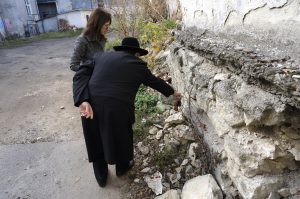
Inspecting a building foundation in Rohatyn built with Jewish headstones, before it was dismantled. Photo © RJH.
Jewish Headstone Recovery Project – a detailed description of the history and current status of the project to recover and return Jewish headstone fragments in Rohatyn, on the website of Rohatyn Jewish Heritage (RJH)
- Old Jewish Cemetery Rehabilitation Project – a detailed description of the overall project to preserve and promote the cemetery, including development of a memorial incorporating the recovered headstone fragments, on the website of Rohatyn Jewish Heritage (RJH)
- Jewish Grave Markers, Lost and Recovered – an essay on the Jewish headstones and displaced fragments in Rohatyn as a heritage resource, on the website of Rohatyn Jewish Heritage (RJH)
- Jewish Cemeteries of Rohatyn – an overview of the history and current status of the Jewish cemeteries in Rohatyn, on the website of Rohatyn Jewish Heritage (RJH)
- Written in Stone: The Art and Meaning of Rohatyn’s Jewish Grave Markers – an overview of Jewish headstone art and symbolism from various sources, using Rohatyn matzevot as examples, on the website of Rohatyn Jewish Heritage (RJH)
- It’s All Gone, It’s Still There – a photo and text essay from 2013 covering collections of recovered Jewish headstone fragments in Lviv, Ivano-Frankivsk, and Rohatyn, from Christian Herrmann’s Vanished World blog site

